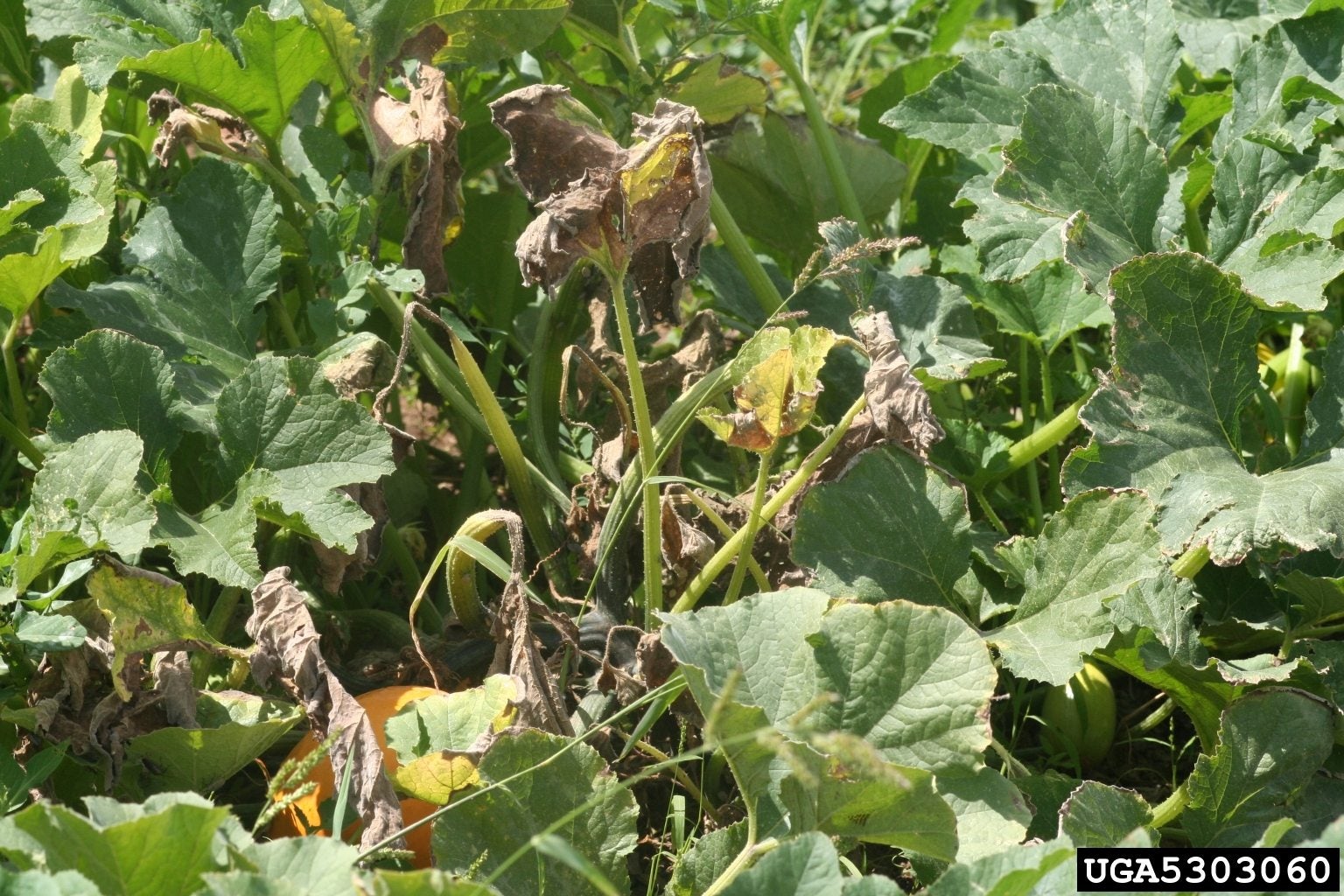Troubleshooting Pumpkin Plant Wilt: How To Fix Wilting Pumpkin Plants

Alas, your glorious strong, healthy pumpkin plants are wilting and yellowing. There’s nothing as sad as having seemingly healthy plants one day and then almost overnight, witness drooping, discolored foliage. Before you can figure out a fix to the problem, it’s probably a good idea to get an idea of why pumpkin plants wilt.
Help! My Pumpkin Plants are Wilting!
There are several reasons for pumpkin plant wilt. The best way to figure out which one may be the cause of your wilting pumpkin plants is to rule out the simplest explanation first. Lack of water might be the reason for pumpkin leaves that are wilting. Although the large leaves aid in shading the soil and keeping roots cool, the plants still need water. During the heat of the summer, pumpkins need between 1 and 1 ½ inches (2.5-4 cm.) of water per week. Water the pumpkins deeply and slowly once a week at the base of the plant rather than overhead briefly each day. During extended heat waves, you may even need to water a bit more. It’s not unusual to see wilting pumpkin plants during the heat of the day, but this should be temporary. If you see that your pumpkins are wilting in the morning, they’re most likely water-stressed.
Diseases causing wilting pumpkin plants
Other reasons for pumpkin leaves wilting and yellowing are less benign than a simple lack of irrigation. In these cases, wilting is caused by disease and can get so severe that the plant will die.
- Bacterial wilt– Bacterial wilt is caused by Erwinia tracheiphila, a bacterium that is spread via the cucumber beetle. It invades the vascular system of the pumpkin, blocking water uptake. Usually it begins with one leaf and then spreads to the entire plant. If you suspect bacterial wilt, cut a stem at ground level. Hold the cut end to your finger. If sticky goo comes away when you remove your finger, you have bacterial wilt. Since this disease is caused by beetles, insect control is the best bet to thwart the disease before it assaults the entire pumpkin patch.
- Fusarium fungus– Fusarium crown rot is a fungal disease that lives in the soil and is spread through movement of wind, of you, of mechanical equipment, from critters, etc. The initial symptoms are yellowing of the foliage, followed by wilting and necrosis. The disease can overwinter in the soil and has no chemical control. The only thing to be done to combat crown rot is a lengthy crop rotation.
- Phytophthora blight– Phytophthora blight is another fungal disease that is an equal opportunity infection, attacking many types of veggies, not just pumpkins. Again, it overwinters nicely and lives indefinitely in the soil. It thrives in wet, cool fall weather. Primary symptoms are collapsing vines and pumpkins covered in a cottony mold. Again, the disease is spread through movement. Practice crop rotation and provide well-draining soil to fight this blight and use fungicides as directed. Pythium is also a fungal disease with similar symptoms and controls.
Pumpkin leaves wilting due to insects
While diseases are a factor as to why a pumpkin has wilting leaves, insects are also often responsible.
- Vine borers– Squash vine borer larvae love to feed on pumpkins at the base of a stem, resulting in yellowing and wilting of leaves. The resulting holes are often seen to be filled with the larvae green to orange poop. Once the larvae are munching away on the pumpkins, there is little you can do. Pull up any plants killed by the borers and if timing permits in your region, plant a second batch. The best way to quash the insects is to look for the adults buzzing around at the end of June, before they lay their eggs. Set yellow trap pans filled with water. The adults are attracted to yellow and will fly to the trap and get trapped in the water.
- Squash bugs– Squash bugs are another insect fond of snacking on your pumpkins. Again, their feeding causes yellowing and wilting foliage. The large, flattish adults overwinter in cozy niches and emerge in the spring to feed and lay eggs on squash foliage. They suck the sap out of foliage disrupting the flow of nutrients and water to the plant. Both eggs, nymphs, and adults may be present at any one time. Remove or knock off any nymphs and adults and drop them into soapy water. Look under leaves. Insecticides may also be used to manage squash bugs, especially if the plants are wilting early in the growing season.
Overall, pumpkins can be afflicted with a number of things that can cause wilting and yellowing. The best defense is to begin with healthy plants in well-draining soil amended with nutritious compost. Water consistently and practice proper fertilization. Keep a close eye on the plants to inspect for insects before they become a problem. Keep the area around the plants weed and plant detritus free. A healthy start will enable the plants to fight off or withstand any potential disease or insect attacks and give you time to facilitate a control plan.
Sign up for the Gardening Know How newsletter today and receive a free copy of our e-book "How to Grow Delicious Tomatoes".

Amy Grant has been gardening for 30 years and writing for 15. A professional chef and caterer, Amy's area of expertise is culinary gardening.
